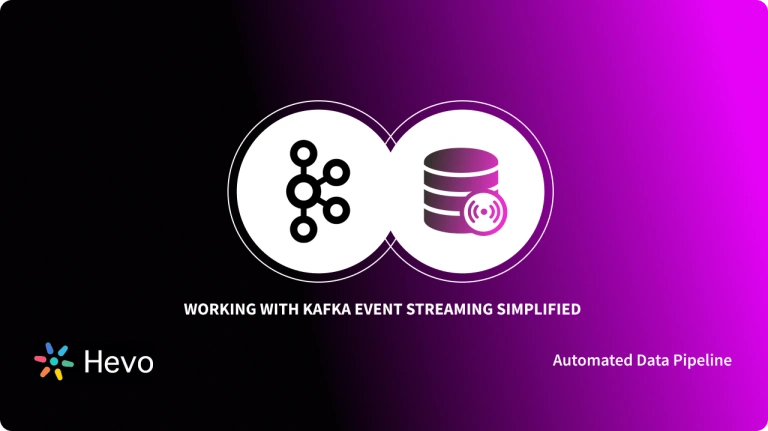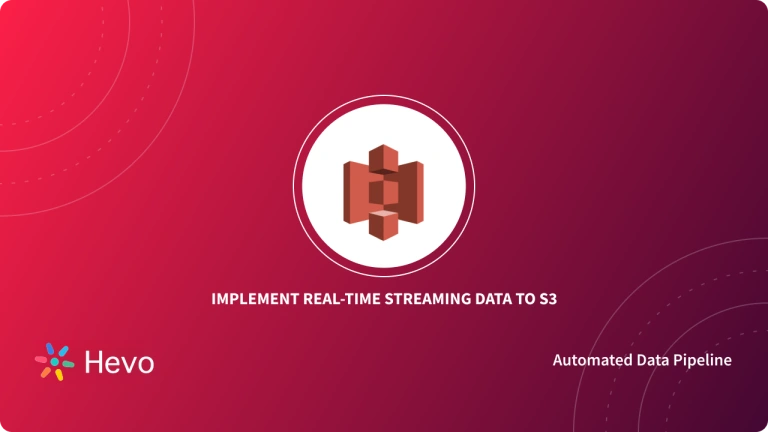In a system that continuously generates data, each data point refers to an Event. Event Streams are defined as a continuous Stream of those data points or Events. Event Streams are also called Data Streams in the developer community due to the fact that Event Streams consist of continuous data points. Event Stream Processing is the process of taking action on the generated Events.
This article talks about Event Streams and Event Stream Processing in great detail touching upon topics like how does Event Stream Processing works, the difference between Event Stream Processing and Batch Processing, its benefits, its use cases, and finally an example to illustrate Event Stream Processing in the form of IBM Event Streams before wrapping it up.
Table of Contents
Introduction to Event Streams
One of the prominent challenges with microservices is the coupling that might occur between services. Conventional architecture is an ‘ask, don’t tell’ architecture where the data is gathered on demand. Say there are 3 services in question, Service A, B, and C. Service A asks the other services ‘What’s your current state?’ while assuming the other services are always available for a response. This leaves a user in a fix if the other services are offline.
To compensate, microservices use retries as a workaround for the problem of network outages or any ill effects caused by changes in the network topology. But this ends up adding an extra layer of complexity and increasing the cost further.
An Event-driven architecture follows a ‘tell, don’t ask’ approach to resolve the issues faced by the traditional architecture where Services B and C in the above example publish Continuous Streams of data like Events and Service A subscribes to these Event Streams. Service A can then process the facts, collate the results, and cache them locally.
Utilizing Event Streams this way can deliver numerous benefits like:
- Systems can closely mimic real-world processes.
- Increased utilization of scale-to-zero functions (serverless computing), because more services can remain idle until they are needed.
- Improved flexibility.
Real-time data sync is extremely important for getting instant analysis of your data. Use the stream data processing feature of Hevo to:
- Load your streaming data in real time.
- Transform your data using built-in transformations.
Introduction to Event Stream Processing
Event Stream Processing (ESP) is a set of technologies that helps in building an Event-driven architecture. As mentioned before Event Stream Processing is the process of taking action on the Events generated in an Event-driven architecture. One can take action in a number of ways like:
- Performing Calculations.
- Transforming Data.
- Analyzing Data.
- Enriching Data.
You can create a pipeline of actions to transform Event data, which will be discussed in the next section which forms the crux of Event Stream Processing.
Understanding How Event Stream Processing Works
Event Stream Processing incorporates two types of technologies. The first type of technology is a system that stores Events in chronological order and the second type is software used for processing Events.
The first component deals with data storage and stores data on the basis of a timestamp. For e.g. recording the outside temperature every minute for an entire day is a good example of Streaming Data. Each Event, in this case, is the temperature measurement followed by the exact time of measurement. This is usually handled by technologies like Apache Kafka. The second component is known as Stream Processors or Stream Processing Engines.
Most commonly Apache Kafka is used by developers to store Events temporarily and process them. It also allows you to build Event Streams-based pipelines where a processed Event is passed to different Event Streams for further processing.
These are the aspects of Event Stream Processing that are supported by Apache Kafka:
- Publishing and subscribing to Event Streams.
- Storing Streams of Events reliably without any time constraint.
- Processing Streams of Events as and when they occur.
Event Stream Processing vs Batch Processing
With the advent of technology, companies are dealing with a far greater volume of data than they did perhaps 10 years ago. So more advanced data processing tools are required to keep up with this rapid change. A traditional application undertakes the intake, storage, processing of data along with storage of the processed results.
These processes usually occur in batches wherein your application will have to wait until it has sufficient data before it can start processing. The time your application might have to wait for data; is not acceptable for real-time or time-critical applications that would need immediate data processing.
Therefore to overcome this challenge, Event Streams jump into the fray. In Event Stream Processing each single data point or Event will get processed immediately which means there is no queue of data points whatsoever which makes it ideal for real-time applications.
In addition to this, Stream Processing allows you to detect patterns, look at various levels of focus and take a look at data from multiple Streams simultaneously. Compared to the hassle of Batch Processing, Event Stream Processing can work with a lot less hardware by spreading the processing over time.
Here’s a tabulation of the differences between Batch Processing and Stream Processing to further drive the point home.
Key Benefits of Event Stream Processing
Event Stream Processing comes into play when you have to need to take immediate action on Event Streams. This will matter the most for high-speed technologies that are widely in circulation nowadays, therefore, establishing Event Stream Processing as the go-to solution to handle voluminous data. A few benefits of leveraging Event Stream Processing as a part of your workflow are:
- You can build Event Stream Pipelines to serve advanced Streaming use cases. For e.g. one can utilize an Event Stream Pipeline to enrich Event data with metadata and transform said data object for storage.
- You can make real-time decisions by utilizing Event Stream Processing as a part of your workflow.
- You can scale your infrastructure effortlessly when the data volume increases.
- Event Stream Processing enables continuous Event Monitoring which allows you to create alerts to detect patterns and anomalies.
- You can analyze and process large amounts of data in real-time giving you the ability to filter, aggregate, or cleanse the data before storing it.
Use Cases of Event Stream Processing
As IoT continues to evolve, so does the need for executing real-time analysis. As data processing architecture becomes increasingly Event-driven, ESP continues to become an essential tool.
Event Streaming is applied to a wide number of use cases spanning various industries and organizations. Let’s take a look at a few industry domains that have benefited from leveraging Event Stream Processing to ease their data processing methodology:
- Financial Sector: Processing payments and financial transactions in real-time.
- Healthcare Sector: Monitoring patients in hospital care and predicting the changes in their condition to ensure a timely treatment in cases of emergencies.
- Logistics and Automotive Sector: Tracking and monitoring cars, trucks, fleets, and shipments in real-time.
- Retail, Hotel, and Travel Sector: Collecting and immediately responding to customer interactions and orders.
- Manufacturing Sector: To continuously capture and analyze sensor data from IoT devices or other equipment.
Event Streaming Platform Example: IBM Event Streams
IBM Event Streams is a high-throughput, fault-tolerant Event Streaming platform based on Apache Kafka. You can build intelligent Event-driven applications that leverage existing data to help you establish an Event-driven architecture.
The deployment models for IBM Event Streams are quite flexible in nature allowing you to deploy across a number of Clouds Services like Microsoft Azure, AWS (Amazon Web Services), GCP (Google Cloud Platform), IBM (International Business Machines) Cloud, or a more traditional On-premise deployment.
A few features of IBM Event Streams that make it such a steal are as follows:
- It allows you to deploy production-ready Apache Kafka onto Red Hat OpenShift in minutes.
- You can exploit existing data to help your enterprise become Event-driven.
- You can build a fair number of intelligent apps on IBM Event Streams.
- It comes forth with Schema Registry which is a distributed storage layer for schemas that use Apache Kafka as its underlying storage mechanism.
- It provides unrivaled Message Queue connectivity.
- Reliable disaster recovery and security designed for mission-critical use.
- It allows you to publish Events from anywhere with the REST Producer API.
Conclusion
This article talks about Event Streams and Event Stream Processing in considerable detail while highlighting the key points that make it an indispensable practice in a world that is becoming largely Event-driven. Key points like its working, benefits, and use cases along with a tool that comes in handy when leveraging Event Stream Processing as a part of your enterprise’s Data Processing workflow.
Extracting complex data from a diverse set of data sources can be a challenging task and this is where Hevo saves the day! Hevo offers a faster way to move data from Databases or SaaS applications into your Data Warehouse to be visualized in a BI tool. Hevo is fully automated and hence does not require you to code.
VISIT OUR WEBSITE TO EXPLORE HEVOWant to take Hevo for a spin?
SIGN UP and experience the feature-rich Hevo suite first hand. You can also have a look at the unbeatable pricing that will help you choose the right plan for your business needs.
Share your experience of working with Event Streams with us in the comments section below!



